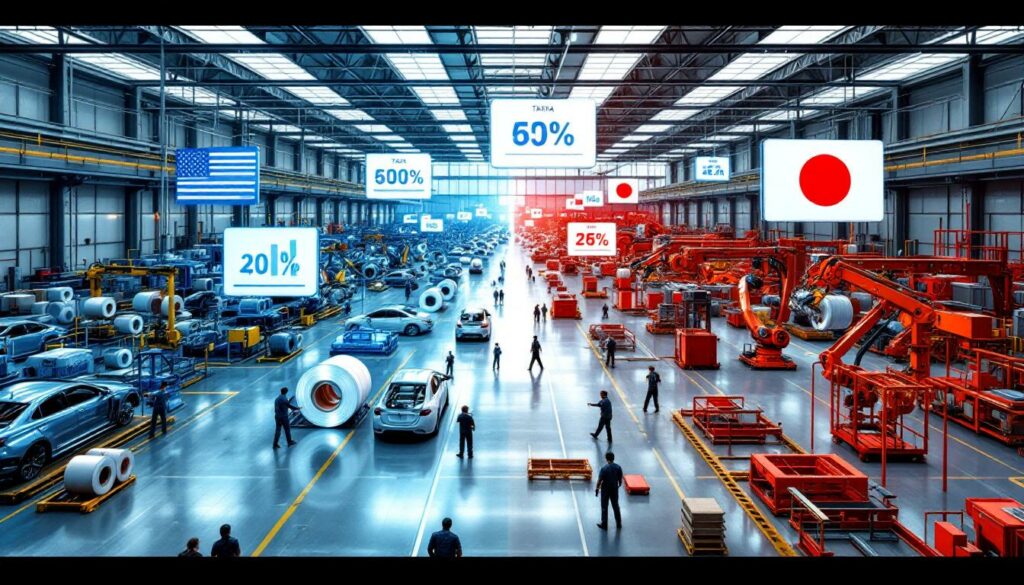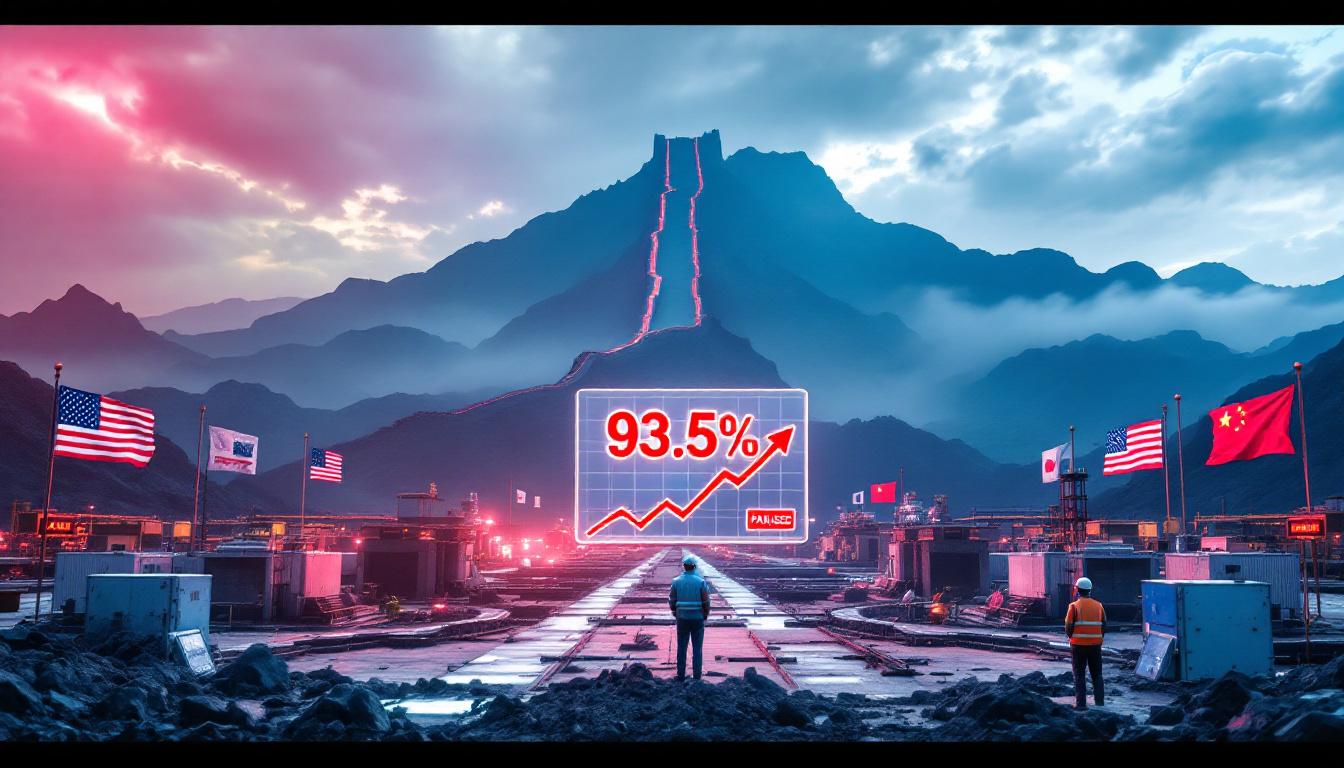Understanding the New Trade Agreement's Framework
The landmark US-Japan trade deal announced in July 2025 represents a significant shift in bilateral trade relations between two of the world's largest economies. This comprehensive agreement contains several provisions that will reshape automotive manufacturing and steel industries in both countries for years to come.
Key Terms of the US-Japan Trade Deal
The cornerstone of the new agreement involves a substantial reduction in Japanese auto import tariffs from 25% to 15%, providing Japanese manufacturers with improved access to American consumers. While this represents a 40% reduction in tariff rates, it maintains significant protection for domestic producers compared to pre-2024 levels.
Despite concessions on automotive tariffs, the agreement maintains robust 50% sectoral tariffs on Japanese steel imports, reflecting the strategic importance of domestic steel production to US industrial policy. This dual approach attempts to balance consumer interests with manufacturing protection.
Perhaps most striking is Japan's commitment to invest a staggering $550 billion in a US strategic industrial fund. As then-President Donald Trump characterized it during negotiations, "They gave us $550 billion because they didn't want to pay [the higher rate of 25% they currently pay]." This investment package functions essentially as what Trump termed a "signing bonus" rather than a loan.
"It's not a loan or anything. It's a signing bonus," Trump explained, highlighting the unprecedented nature of this economic arrangement between allies.
The agreement includes a unique 90/10 profit-sharing arrangement between the US and Japan for returns generated by the strategic fund, with American interests receiving the dominant share of financial benefits. The fund targets investments across several critical sectors:
- Energy infrastructure and production
- Semiconductor manufacturing
- Critical minerals extraction and processing
- Pharmaceutical research and development
- Shipbuilding and maritime technologies
For American automakers, the deal removes significant barriers that have historically prevented US automotive exports to Japan. Most notably, US automotive standards will be approved in Japan for the first time, eliminating a longstanding technical barrier that effectively blocked many American vehicles from the Japanese market.
Strategic Industrial Investment Allocation
The $550 billion investment fund represents one of the largest single foreign investments in US industrial capacity in modern history. The agreement specifies that these funds will primarily target revitalizing America's strategic industrial base, with particular emphasis on sectors facing competitive challenges from China and other manufacturing powerhouses.
While specific allocation percentages for the investment fund remain undisclosed, industry analysts anticipate significant portions will flow toward semiconductor production, critical minerals security and advanced energy technologies. The automotive sector stands to benefit both directly through manufacturing investments and indirectly through improved supply chain resilience.
The fund's 90/10 profit-sharing model ensures that most economic benefits flow to US interests, while Japanese partners maintain a strategic stake in successful outcomes. This arrangement reflects a calculated compromise that benefits both nations while preserving American economic priorities.
What Does This Mean for US Automotive Production?
The implications of the US-Japan trade deal for domestic auto manufacturing are multifaceted, with potential shifts in production location, model availability, and competitive dynamics between manufacturers.
Current US Automotive Production Landscape
According to industry forecasts, US light vehicle production is projected to reach 10.3 million units in 2025, essentially flat compared to 2024 production levels. Sam Fiorani of AutoForecast Solutions notes that "production is expected to remain stable until 2028," suggesting limited organic growth in the domestic market regardless of trade policy changes.
One notable trend affecting production is the temporary capacity shift from electric vehicles toward internal combustion engines. This reallocation reflects ongoing adjustments in consumer demand and manufacturing capabilities as the industry navigates the complex transition toward electrification.
Current production capacity utilization across US automotive plants varies significantly by manufacturer, with some Japanese brands already operating with excess capacity while others face constraints that limit their ability to shift production onshore.
How Will Japanese Automakers Respond?
The reduced tariff rate creates a complex strategic calculation for Japanese manufacturers with US operations. While a 15% tariff remains substantial, it may not justify new manufacturing investments for all vehicle models.
Potential US Manufacturing Expansion
Several Japanese automakers are considering expanding their American manufacturing footprint in response to the modified tariff structure. According to Sam Fiorani of AutoForecast Solutions, "Toyota is possibly looking to localize 4Runner production" in the United States. Similarly, Mazda is reportedly considering US-based production for its popular CX-5 crossover.
However, these expansions face practical limitations. Fiorani points out that there is a "limited number of high-volume Japanese imports suitable for US production." Many imported models lack sufficient sales volume to justify the capital expenditure required for domestic manufacturing facilities.
Existing capacity constraints also influence these decisions. As Fiorani notes, "Nissan already has too much factory space," suggesting that some Japanese manufacturers may opt to reconfigure existing US plants rather than build new facilities.
Strategic Considerations for Japanese Manufacturers
Japanese automakers must balance multiple strategic factors when deciding whether to import vehicles at the reduced 15% tariff rate or invest in domestic production:
- Global production volume requirements – Many models serve multiple international markets, making centralized production more efficient
- US market size for specific models – Only high-volume sellers justify localized production
- Capital investment requirements – New production lines or plants require substantial upfront investment
- Supply chain configuration – Existing supplier relationships may favor specific manufacturing locations
- Production flexibility needs – The ability to shift production between markets as demand fluctuates
For niche market vehicles like certain Subaru models, the economics likely favor continued importation even with tariffs. As Fiorani explains, this could mean "more expensive vehicles for consumers" in these specific segments, but the increased costs may be preferable to the alternative of discontinuing these models entirely in the US market.
What Impact Will This Have on US Steel Demand?
The automotive industry represents a critical customer for American steel producers, with any shift in production patterns potentially creating ripple effects throughout the domestic steel industry.
Automotive Steel Consumption Patterns
According to Phil Gibbs, metals equity analyst at Keybanc Capital Markets, the automotive sector consumes approximately 40% of all flat steel output in the United States. This makes vehicle manufacturing the single largest customer segment for domestic flat steel producers.
The automotive industry's steel consumption focuses primarily on galvanized and cold-rolled coil products, which provide the corrosion resistance and formability required for modern vehicle manufacturing. These high-value steel products command premium pricing and typically offer better margins for steel producers than commodity-grade products.
Beyond flat products, the auto industry also accounts for 40-50% of special bar quality (SBQ) long steel products used in applications like drive shafts, connecting rods, and other critical vehicle components. This specialized steel category represents some of the highest-value steel products in the market.
"With a more definitive price on imported metals, procurement is much less of a headache," explains Arthur Wheaton of Cornell University, highlighting how the stable tariff structure provides certainty for supply chain planning.
Steel intensity per vehicle—the amount of steel used in each car or truck—remains a critical metric for the industry. While lightweighting trends have reduced steel content in some models, advanced high-strength steels have maintained the material's relevance even as manufacturers seek to improve fuel economy.
Potential Steel Demand Scenarios
The Trump tariff impact on steel demand will largely depend on how Japanese automakers adjust their production strategies. Two primary scenarios emerge:
Scenario 1: Increased Domestic Production
If Japanese manufacturers respond by significantly expanding US production facilities, domestic steel demand could see moderate growth. New or expanded auto plants would likely favor domestic steel suppliers to minimize supply chain complexity and reduce logistics costs.
Under this scenario, we could expect:
- Higher demand for US-produced automotive-grade steel
- Potential supply chain shifts favoring domestic suppliers
- Improved capacity utilization at American steel mills
- Upward pressure on domestic steel pricing and margins
- Increased demand for specialized grades like advanced high-strength steels
This scenario would particularly benefit integrated steel producers and specialty steel manufacturers focused on automotive-grade products.
Scenario 2: Increased Imports with Minimal Production Shifts
Alternatively, if Japanese automakers determine that absorbing the 15% tariff makes more economic sense than investing in new US production, the impact on domestic steel demand would be limited. Under this scenario:
- Domestic steel demand would see minimal change from current levels
- Supply chains would maintain existing configurations
- Price competition would intensify from imported vehicles
- Steel mills might face margin pressure as automakers seek cost reductions elsewhere
- Specialty steel producers might face less growth in high-value product segments
The maintenance of 50% sectoral US iron ore tariffs on Japanese steel imports creates a significant barrier that will likely preserve domestic steel sourcing for US-based manufacturing regardless of which scenario predominates.
How Will Market Competition Evolve?
The revised tariff structure creates a new competitive landscape for both US and Japanese automotive manufacturers, with potential shifts in market share, pricing strategies, and product offerings.
Competitive Dynamics Between Manufacturers
Japanese automakers already maintain a substantial manufacturing presence in the United States, with Toyota, Honda, Nissan, and others operating major production facilities across the country. This existing footprint creates what Marick Masters of Wayne State University describes as competition "on two fronts" with US-owned manufacturers.
"Japan-based auto companies also manufacture a large quantity of vehicles in the US, meaning that they compete directly with US-owned manufacturers on two fronts," Masters explains. This dual-channel competition—through both imports and domestic production—creates complex competitive dynamics.
The Detroit Three (General Motors, Ford, and Stellantis) face particular challenges in this environment. As Japanese manufacturers potentially expand their US manufacturing operations, domestic brands may face increased pressure on market share and pricing.
Several competitive factors will shape market evolution:
- Production cost differentials between US and Japanese manufacturers
- Model availability and product mix adjustments
- Pricing strategy responses to changed tariff structures
- Supply chain efficiency and vertical integration approaches
- Electric vehicle transition strategies as the market evolves
For smaller Japanese manufacturers with limited US sales volumes, the competitive calculus becomes even more challenging. As Sam Fiorani notes, brands like Mitsubishi might face difficult decisions about their continued presence in the US market if they cannot absorb the tariff costs or justify local production.
US-Japan Automotive Trade Balance
The United States maintains what Masters characterizes as a "sizable trade deficit" with Japan in the automotive sector. This imbalance has been a longstanding concern for US policymakers and a key driver behind previous tariff increases.
The new agreement may affect this trade balance through several mechanisms:
- Reduced import tariffs potentially increasing Japanese vehicle imports
- Removal of barriers to US exports potentially increasing American vehicle exports to Japan
- Localized production shifts reducing the need for imports from Japan
- Model mix adjustments based on tariff and production economics
Industry analysts anticipate modest improvements in the bilateral automotive trade balance, though structural factors like consumer preferences for specific vehicle types and brand positioning will limit the magnitude of change in the near term.
What Are the Investment Implications?
Financial markets have responded decisively to the US-Japan trade agreement, with implications for equity valuations, capital allocation decisions, and long-term investment strategy components in both the automotive and steel sectors.
Stock Market Reactions
Following the announcement of the trade deal, Japanese auto company shares experienced a significant rally, reflecting investor optimism about improved access to the lucrative US market. This positive reaction indicated market expectations that the reduced tariff rate would enhance profitability for Japanese manufacturers.
In contrast, shares of the Detroit Three manufacturers saw more modest increases, suggesting investor uncertainty about the competitive implications of the agreement. The mixed reaction highlighted the complex balance between improved trade certainty and increased competitive pressure.
Steel company stocks showed similarly nuanced responses, with integrated producers maintaining stable valuations while specialty steel manufacturers focused on automotive applications saw more positive momentum. This differentiated response reflected varying exposure to potential changes in automotive production patterns.
The strategic investment fund announcement created positive sentiment across multiple industrial sectors, with semiconductor, energy, and critical minerals companies seeing particular investor interest based on anticipated funding allocations.
Long-term Investment Considerations
Beyond immediate market reactions, the trade agreement creates several structural considerations for long-term investors:
Capacity expansion decisions by manufacturers will require substantial capital expenditures, potentially creating investment opportunities in both automotive production facilities and supporting infrastructure. Toyota and Mazda's potential production localization represents just the beginning of what could be significant capital deployment.
Supply chain investments may accelerate as manufacturers seek to optimize their operations under the new tariff regime. Companies providing localization solutions, logistics optimization, and supply chain technology may benefit from this transition.
Regional economic development opportunities may emerge in manufacturing centers that attract new production facilities or expansions. Communities with existing automotive manufacturing clusters may see additional investment as Japanese manufacturers expand their domestic footprint.
The table below summarizes potential investment implications across key sectors:
| Sector | Positive Factors | Challenges | Investment Outlook |
|---|---|---|---|
| US Auto Manufacturers | Certainty in trade policy, strategic fund investment | Increased competition from localized Japanese production | Neutral to slightly positive |
| Japanese Auto Manufacturers | Reduced tariff burden, potential market share gains | Capital requirements for localized production | Positive |
| Steel Producers | Maintained protection via 50% tariffs, potential increased domestic demand | Limited growth in overall production volume | Neutral to positive |
| Semiconductor | Strategic fund allocation for domestic production | Global competition, technology requirements | Strongly positive |
| Critical Minerals | Focus on supply chain security, fund allocation | Project development timelines, permitting | Positive |
How Will Consumers Be Affected?
American car buyers stand to experience several effects from the revised trade agreement, with implications for vehicle pricing, product availability, and purchase decisions.
Vehicle Pricing Implications
The reduction of Japanese auto import tariffs from 25% to 15% represents a significant change that will influence pricing strategies for both imported and domestic vehicles. While imported models will still face substantial tariffs, the 10 percentage point reduction provides Japanese manufacturers with greater pricing flexibility.
For vehicles that continue to be imported from Japan, consumers can expect moderated price increases compared to the previous tariff structure. However, the 15% tariff still represents a substantial cost that must either be absorbed by manufacturers or passed along to consumers.
Arthur Wheaton of Cornell University notes that the auto industry "strongly prefers certainty, even if more expensive," suggesting that stable trade policies may ultimately benefit consumers through more predictable pricing and availability, even if absolute prices remain higher than in a zero-tariff environment.
Domestic manufacturers will likely adjust their pricing strategies in response to any changes from Japanese competitors. This competitive pricing dynamic may help moderate price increases across the broader market, benefiting consumers indirectly even for American-made vehicles.
Product Availability and Consumer Choice
The trade agreement's impact on vehicle availability will vary significantly by manufacturer and vehicle segment. For high-volume models that may shift to US production, availability could actually improve as supply chain disruptions from international shipping are reduced.
For niche vehicle segments, the outlook is more complex. Sam Fiorani highlights that models like the Subaru Outback could face price increases if they continue to be imported under the 15% tariff regime. In some cases, manufacturers of low-volume specialty vehicles might determine that the US market no longer justifies the regulatory and tariff costs, potentially reducing consumer choices in specific segments.
Mitsubishi, with its relatively small US market presence, represents a manufacturer that could face difficult decisions about its continued presence in the American market. If such smaller manufacturers reduce their US offerings, consumers would experience reduced choice in certain vehicle categories.
Electric vehicle availability may see limited direct impact from the trade agreement, as most Japanese EV models sold in the US are already produced domestically or in markets other than Japan. However, the strategic fund's investments in critical minerals and semiconductors could indirectly support EV manufacturing and availability in the longer term.
What Are the Broader Economic Implications?
Beyond the immediate impacts on automotive and steel industries, the US-Japan trade agreement carries significant implications for manufacturing employment, supply chain structures, and iron ore market trends.
Manufacturing Employment Effects
The potential expansion of Japanese automotive manufacturing in the United States could create new employment opportunities in production facilities and throughout the supply chain. While specific job creation projections remain uncertain, any significant production localization would generate direct manufacturing positions and indirect employment in supporting industries.
Regions with existing automotive manufacturing clusters would likely see the greatest employment benefits, as manufacturers typically expand in areas where they already maintain operations and where skilled workforces are available. States like Kentucky, Tennessee, Alabama, and Ohio—which host significant Japanese automotive operations—could see particular growth.
For steel industry employment, the maintained 50% tariff on Japanese steel imports provides continued protection for domestic jobs. If automotive production expands domestically, steel industry employment could see modest growth, particularly in specialized product categories serving the automotive sector.
The strategic industrial fund's investments across energy, semiconductors, critical minerals, pharmaceuticals, and shipbuilding sectors promise additional manufacturing employment growth beyond the automotive sector. This diversified approach could create more resilient employment opportunities less subject to cyclical automotive demand patterns.
Supply Chain Transformations
The agreement may accelerate reshoring trends for automotive components and materials, particularly for parts with high logistics costs or those considered strategically important. As manufacturers seek to optimize their operations under the new tariff structure, supply chain localization becomes increasingly attractive.
Steel industry capacity utilization could improve if domestic automotive production expands, potentially justifying capital investments in modernization and expansion at American steel facilities. The focus on automotive-grade products with higher margins could enhance the industry's economic sustainability.
Logistics and transportation systems will
Ready to Catch the Next Major Mineral Discovery?
Stay ahead of the market with Discovery Alert's proprietary Discovery IQ model, which instantly notifies investors of significant ASX mineral discoveries, turning complex data into actionable insights. Understand why major mineral discoveries can lead to substantial returns by exploring the dedicated discoveries page and begin your 30-day free trial today.




